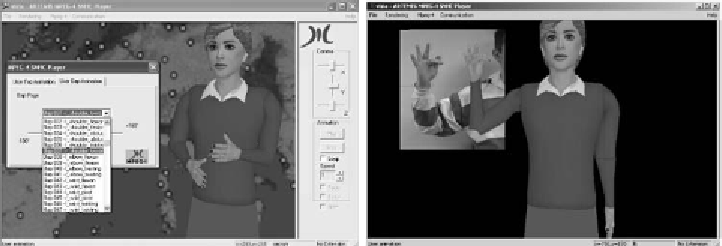Game Development Reference
In-Depth Information
Figure 6. The 3AI: (a) BAP editing by using a dedicated user interface
allowing to tune the value for each BAP, (b) interactive tracking of gestures
in image sequences.
(a)
(b)
In order to address the avatar animation issue, we developed a dedicated
authoring tool named ARTEMIS Animation Avatar Interface (3AI), to ease the
editing and extraction of face and body animation parameters. The 3AI authoring
tool also provides the following functionalities: (1) loading an FBA compliant
avatar; (2) 3D composition of objects such as images, video sequences, avatars
or anatomical part models (face, hand, arm, and 3D scenes; (3) calibration of 3D
face and body models according to the anthropometric characteristics of the
actor in a video sequence (dimensions of the palm, length of the fingers); (4) face
tracking in natural video sequences and FAP instantiation (Malciu, 2000); (5)
interactive extraction of BAPs to describe any posture or corresponding to the
posture shown in the video sequence (see Figure 6b); (6) animation parameters
editing through selection of key-frames and end-effector positioning; and finally
(7) avatar animation according to a FAPs/BAPs file source and network
resource (e.g., UDP server). Some of these functionalities are visually repre-
sented in Figure 6.
Animation Parameters Compression
The FBA specifications provide, for both face and body animation parameters,
two encoding methods (predictive and DCT-based).
In the first method (Figure 7a), FAPs/BAPs are coded with a predictive coding
scheme. For each parameter to be coded in frame n, the decoded value of this


Search WWH ::

Custom Search